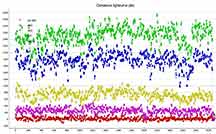

This event is faint, but long enough at 2.6s that we can integrate and should get a detection. It's high up, at alt=40, Az=168 in Northern Sagittarius, halfway between the tail feathers of Aquila, and the Teaspoon formation.
Probably need to do 16x or 32x to get this. If Karl's using the NTSC Watec unit I just lent to him to replace his "measles" hot pixel plagued original Watec, then his sensitivity is better now, almost as good as Kirk's.
I would recommend recording on Brixia a full 1.5 minutes after the event time, then be prepared to quickly do a blind GoTo to the target Glia. This may require testing to be sure you know what the Glia field looks like. There's a couple of obvious patterns to look for; the close bright double star right of the target, and the bright tight triplet of stars above/left of the target. Verify the good targeting of your scope. Be very careful when you do your 2-star alignment that you move your star to the center of the eyepiece FROM THE SAME QUADRANT for both align stars, so the gear slack is taken up the same for both RA and Dec drives and for both stars from the same direction. In my experience, this then gives ~ perfect GoTo. If you do NOT so this, my experience is that you might be off by a full eyepiece diameter, so this is important and especially for these two very close events.
 |
 |
This event was only 5 minutes after Brixia. Kirk and I got the scopes moved successfully on target and have data to reduce. Karl was not able to ID the field, got no data.
I observed from Sunlit Lane, same spot as for Brixia 5 minutes earlier. I got on the target pretty efficiently, after the Brixia event, with a blind GoTo using the Watec only. I recognized the star patterns, got it centered, and started recording. But during the recording, the scope slowly drifted and about a minute after the occultation it was getting close enough to the top of the chip that I manually moved it down. That caused a loss of tracking and so I had to clip the study range at the loss of tracking. Still, the main event was cleanly gotten. I observed at 16x integration.
The LCD chart above shows a very close neighbor. The danger is that the Target aperture will "snap to" the other star during the occultation. To prevent this, I lowered the tracking box size to the minimum of 11 pixels, I reduced the aperture size to 3 px from the usual 4 px that I usually do. And finally, I jogged the tracking box up and to the right away from the actual target, knowing the aperture would snap-to the star, but not go outside the tracking box and therefore not snap-to the target. I followed it during the reductions and it seemed to behave as I planned.
The drop predicted was 1.8 magnitudes but the observed drop was 1.2 magnitudes. Some of this difference might be bandpass difference from the V magnitude drop published in OW desktop. I did not see the aperture "snap to" the neighbor star during the occultation during the PyMovie photometry, so I think the photometry is not compromised.
My comment during the taping was that there was "a hell of a lot of twinkling" even at 16x. I may have had more daytime heat re-radiating, causing turbulence, while Kirk was closer to sea level inside laminar air, which may mean he didn't have so much twinkling as I saw. My FP histogram is identical to Kirk's nicely past the 5-sigma level but not by a huge amount. My light curve is clearly noiser, but I had a longer 2.88s occultation and so that gave a higher than otherwise passage of the FP test.
magDrop report: percentDrop: 65.5, magDrop: 1.156 +/- 0.386 (0.95 ci)
DNR: 2.40
D time: [09:02:49.8411]
D: 0.6800 containment intervals: {+/- 0.1333} seconds
D: 0.9500 containment intervals: {+/- 0.4196} seconds
D: 0.9973 containment intervals: {+/- 1.1072} seconds
R time: [09:02:52.7211]
R: 0.6800 containment intervals: {+/- 0.1333} seconds
R: 0.9500 containment intervals: {+/- 0.4196} seconds
R: 0.9973 containment intervals: {+/- 1.1072} seconds
Duration (R - D): 2.8800 seconds
Duration: 0.6800 containment intervals: {+/- 0.2129} seconds
Duration: 0.9500 containment intervals: {+/- 0.5822} seconds
Duration: 0.9973 containment intervals: {+/- 1.3528} seconds
 |
 |
 |
 |
 |
 |
I got an obvious 1.8 second event for Glia, 32x from home.
The target is close to two other stars.
At first I tried TME apertures in pymovie, and I edited the mask by clicking in the thumbnail to avoid the other two stars. In pyote, it found the event but failed 4 sigma false positive.
I then did a 12-stack of static apertures, and found only the 2.0 size mask passed 5 sigma false positive.
There were 3 points near the bottom of the event.
If I marked the D and R manually, it found the event but completely failed 3 sigma (even 1 or 2 sigma) false positive.
But if I let it find the event with a min/max of 2 and 20, it passed 5 sigma.
 |
 |
 |
 |
 |